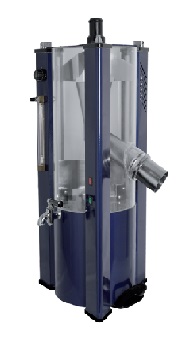Laboratory Flotation Cell
Usage : to study the de-inking effect of printed recycled paper by flotation method in laboratory.
Definition : FLOATATION is a physio-chemical process of separating materials. It is based on
the phenomenon that separation is achieved by influencing the wettability with water of the
particles to be separated. The water repellency of the surface of the particles to be separated is
achieved by the addition of special heteropolar chemicals, which deposit on the surface of the
particles at the same time the treated particles can deposit on air bubbles that are introduce into
the suspension. As a result of buoyancy of the air bubbles the adhering particles are conveyed to
the surface of the suspension to concentrate as a forth, which can be removed.
Device Description : The laboratory flotation cell consists of an acrylic glass vessel for 25 liter
suspension with 300 mm diameter and a drainage pipe. On top of the vessel there is an automatic
foam removal system, driven by a motor with magnetic coupling. On the bottom of the tank there
is a self-suction aeration rotor. The air for the aeration rotor is regulated via an air flow meter.
The air is guided by a baffle plate.
Test Description : The foam outlet is covered and 25 liter of the suspension are poured into the
container. The cover is removed and the motor on top is in place. The chemicals suspensions are
added to the suspension and the motor is turned on. Air bubbles from the aeration rotor create a
foam, which is taken away by the foam paddles, guided to the central foam outlet and collected
in a basket.

